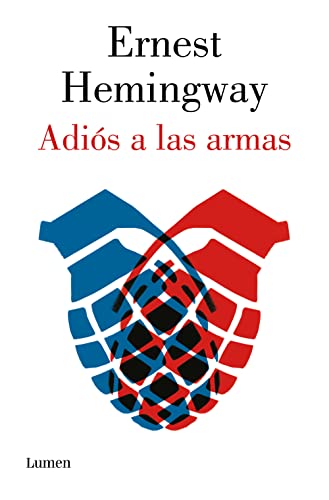
Una inolvidable historia de amor entre una enfermera y un joven soldado idealista en la Italia de la I Guerra Mundial Por el Premio Nobel de Literatura Ernest Hemingway No amaba a Catherine Barkley, ni se le ocurría que pudiera amarla. Aquello era como el bridge, un juego donde te largas a hablar en vez de manejar las cartas. Eso pensaba el teniente americano Frederic Henry, conductor de ambulancias en el frente italiano durante la Primera Guerra Mundial, al poco de conocer a esta bella enfermera británica. Lo que parecía un juego se convirtió en pasión intensa, mientras la guerra lo arrasaba todo y los hombres desfilaban bajo la lluvia, agotados y hambrientos, sin pensar más que en huir de la muerte. Inspirada en las vivencias de Hemingway, Adiós a las armas es ya un clásico de la literatura universal y uno de los mejores retratos de la voluntad humana. Reseñ «Un libro precioso, conmovedor y lleno de humanidad.» Vita Sackville-West «El escritor estadounidense más célebre desde Mark con él la literatura yanqui entró en una nueva dimensión.» Jaime G. Mora, ABC «Su paleta era increíblemente amplia, y exquisita y violenta y brutal y fea, era todas esas cosas. Con todos sus defectos, con todas las dificultades, su vida personal o lo que sea, parecía entender al ser humano.» Michael Katakis «Cuando se logra desmontar una de Faulkner uno tiene la impresión de que le sobran resortes y tornillos y que será imposible devolverla otra vez a su estado original. Hemingway, en cambio, con menos inspiración, con menos pasión y menos locura, pero con un rigor lúcido, dejaba sus tornillos a la vista por el lado de fuera, como en los vagones de ferrocarril. Tal vez por eso Faulkner es un escritor que tuvo mucho que ver con mi alma, pero Hemingway es el que más ha tenido que ver con mi oficio.» Gabriel García Márquez «Hemingway dejaba una intensa vida de aventuras, emociones y sentimientos que supo llevar a sus relatos magistrales. [...] Literatura sencilla, cruda, hermosa y perfecta. Escribía como vivía y ello le permitió crear su propio estilo, único, inconfundible y genial. El estilo Hemingway.» Javier García Recio, La Opinión de Málaga «Pocos como Hemingway cumplen el proverbio "el escritor muere, pero su obra permanece".» Vanessa Jaklitsch, La Razón «Mira el mundo sin prejuicios ni preconceptos y graba con precisión y economía, y con una inmediatez casi aterradora, exactamente lo que ve.» Javier García Recio, La Opinión «Su pasión por narrar lo lleva a la selección de la realidad, a las omisiones, al lenguaje minimalista, a esa voluntad de relatar lo real que se convierte en su poética personal y su lirismo.» Ricardo Lladosa, Zenda Libros
Author

Terse literary style of Ernest Miller Hemingway, an American writer, ambulance driver of World War I, journalist, and expatriate in Paris during the 1920s, marks short stories and novels, such as The Sun Also Rises (1926) and The Old Man and the Sea (1952), which concern courageous, lonely characters, and he won the Nobel Prize of 1954 for literature. Economical and understated style of Hemingway strongly influenced 20th-century fiction, whereas his life of adventure and his public image influenced later generations. Hemingway produced most of his work between the mid-1920s and the mid-1950s. He published seven novels, six short story collections and two nonfiction works. Survivors published posthumously three novels, four collections of short stories, and three nonfiction works. People consider many of these classics. After high school, Hemingway reported for a few months for the Kansas City Star before leaving for the Italian front to enlist. In 1918, someone seriously wounded him, who returned home. His wartime experiences formed the basis for his novel A Farewell to Arms . In 1922, he married Hadley Richardson, the first of his four wives. The couple moved, and he worked as a foreign correspondent and fell under the influence of the modernist writers and artists of the expatriate community of the "lost generation" of 1920s. After his divorce of 1927 from Hadley Richardson, Hemingway married Pauline Pfeiffer. At the Spanish civil war, he acted as a journalist; afterward, they divorced, and he wrote For Whom the Bell Tolls . Hemingway maintained permanent residences in Key West, Florida, and Cuba during the 1930s and 1940s. Martha Gellhorn served as third wife of Hemingway in 1940. When he met Mary Welsh in London during World War II, they separated; he presently witnessed at the Normandy landings and liberation of Paris. Shortly after 1952, Hemingway went on safari to Africa, where two plane crashes almost killed him and left him in pain and ill health for much of the rest of his life. Nevertheless, in 1959, he moved from Cuba to Ketchum, Idaho, where he committed suicide in the summer of 1961.